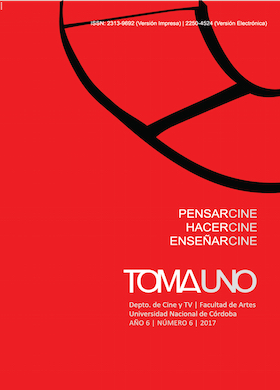Narratives of equality in Argentininian LGBT cinema. Marco Berger’s Hawaii and Papu Curotto’s Esteros
DOI:
https://doi.org/10.55442/tomauno.n6.2018.20906Keywords:
New Argentine Cinema, Argentine LGBT Cinema, Universality, Difference, Pappu Curotto, Marcos BergerAbstract
Taking as a starting point the study of Marco Berger´s Hawaii (2013) and Papu Curotto´s Esteros (2016), the article tackles on the tensions between the so called New Argentine Cinema and LGBT cinema in Argentina. On one hand it explores disjunctions amongst the way that love stories are told as universals, and temporality as an structuring principle, focusing on the figure of zombies or the walking dead; On another, it locates these narrations within the frame of changes in Argentina's politics of equality of the last fifteen years.
Downloads
References
Aguilar, G. (2010). Otros mundos. Un ensayo sobre el nuevo cine argentino, Santiago Arcos editor, Buenos Aires.
Berger, M. (2013). “9 Festifreak: Hawaii”. Disponible en https://www.youtube.com/watch?v=Xfx6Ka7cbEM.
Berger, M. (2012). Teaser Hawaii. Disponible en https://www.youtube.com/watch?v=cJ8yabUJkpo.
Borges, J.L. (2001). “Teoría de Almafuerte” en Textos Recobrados 1931-1955, Emecé, Buenos Aires.
Capelloni, J. (2017). “Papu Curotto, director de Esteros” (Entrevista). Disponible en http://www.fellinia.com.ar/?page_id=40999
Delfino, S. y Rapisardi, F. (2010). “Cuirizando la cultura argentina desde la Queerencia, Centro criollo de políticas de la diferencia”, en Ramón nro 99. Pp. 10-14.
Delfino, S. (2001). “Introducción” en AA.VV, Aventuras. Buenos Aires, Belleza y Felicidad. Pp. 5-6.
González, M.V. (2017). “Papu Curotto: Esteros cuenta una historia de un amor sumamente universal. Sería un error si alguien deja de verla por ser una “peli gay”” http://www.escribiendocine.com/entrevista/0012983-papu-curottoesteros-cuenta-una-historia-de-un-amor-sumamente-universal-seria-unerror-si-alguien-deja-de-verla-por-ser-una-peli-gay-/
Hall, S. (1996). “Cultural Identity and Diaspora” en Patrick Williams y Laura Chrisman Colonial Discourse and Post-Colonial Theory. A Reader, Harvester-Wheatsheaf, Londres.
Martinelli, L. (2016). “Exclusión y libertad en La Raulito de Lautaro Murúa”, en Lucas Martinelli (Compilador) Fragmentos de lo Queer. Arte en América Latina e Iberoamérica, Editorial de la Facultad de Filosofía y Letras, Buenos Aires. Pp. 279-292.
OLIVERA, G. (2012). “Entre lo innombrable y lo enunciable: visibilidades y espacialidades LGBT en el cine argentino (1960-1991)” en Designis, nro 19. Pp. 99-110.
Ranciere, J. (2008). El espectador emancipado, Manantial, Buenos Aires.
Tiquell, X. y Ruiz, S. (2014). “La dimensión política de los discursos sociales”, en De signos y sentidos. Pp. 125-138.
Downloads
Published
Issue
Section
License
Copyright (c) 2018 Fabricio ForastelliThis work is licensed under Creative Commons Attribution-NonCommercial-NoDerivs 2.5 Argentina .


































